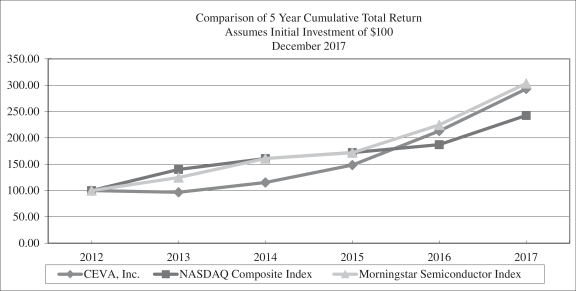We deliver our DSP cores, platforms and AI processors in the form of a hardware description language definition (known as a soft core or a synthesizable core). All CEVA cores can be manufactured on any process using any physical library, and all are accompanied by a complete set of tools and an integrated development environment. An extensive third-party network supports CEVA DSP cores, platforms and AI processors with a wide range of complementing software and platforms. In addition, we provide development platforms, software development kits and software debug tools, which facilitate system design, debug and software development.
In order to reduce the cost, complexity, and risk in bringing products to market, CEVA has developed a suite of system platforms and solutions. These platforms and solutions combine the hardware and software elements that are essential for designers deploying CEVA’sstate-of-the-art DSP cores, platforms and AI processors. Platforms typically integrate a CEVA DSP core, hardware accelerators and coprocessors, optimized software, libraries and tool chain. Our family ofDSP-based platforms are targeted for baseband processing within cellular handsets, Machine to Machine (M2M) type devices and base stations RAN, wired communications, advanced imaging, computer vision and deep neural networks, and audio, voice & sensing andInternet-of-Things related applications.
Customers
We have licensed our signal processing cores, platforms, AI processors and connectivity IPs to leading semiconductor and OEM companies throughout the world. These companies incorporate our IP into application-specific chipsets or custom-designed chipsets that they manufacture, market and sell to consumer electronics companies. We also license our technologies to OEMs directly. Included among our licensees are the following customers: Actions, ASR, Autotalks, Beken, Brite, Broadcom, Celeno, Cirrus Logic, Dialog Semiconductor, DSP Group, Espressif, FujiFilm, iCatch, Intel, Leadcore, LG Electronics, Mediatek, Nextchip, Novatek, NXP, ON Semiconductor, Oticon, Panasonic, RDA, Renesas, Rockchip, Rohm, Samsung, Sanechips, Sharp, Silver Spring Networks, Socionext, Sony, Socionext, Spreadtrum, STMicroelectronics, Toshiba, Vatics, Yamaha and ZTE.
We derive a significant amount of revenues from a limited number of customers. Sales to Spreadtrum represented 23%, 27% and 31% of our total revenues for 2017, 2016 and 2015, respectively. With respect to our royalty revenues, two royalty paying customers each represented 10% or more of our total royalty revenues for 2017, and collectively represented 70% of our total royalty revenues for 2017; two royalty paying customers each represented 10% or more of our total royalty revenues for 2016, and collectively represented 80% of our total royalty revenues for 2016, and two royalty paying customers each represented 10% or more of our total royalty revenues for 2015, and collectively represented 72% of our total royalty revenues for 2015. In 2017, we concluded forty five new licensing deals, of which sixteen were with first time new customers and forty four were for non-handset baseband applications.
International Sales and Operations
Customers based in EME (Europe and Middle East) and APAC (Asia Pacific) accounted for 92% of our total revenues for 2017, 87% of our total revenues for 2016 and 84% for 2015. Customers in each of China and South Korea accounted for greater than 10% of our total revenues for 2017, 2016 and 2015. Information on the geographic breakdown of our revenues and location of our long-lived assets is contained in Note 10 to our consolidated financial statements, which appear elsewhere in this annual report.
Moreover, the majority of our expenses, mainly employee salaries, are paid in currencies other than the U.S. dollar, principally the Israeli currency, New Israeli Shekel (NIS), and the EURO, which subjects us to the risks of foreign currency fluctuations and economic pressures in those regions. As a result, an increase in the value of the currencies other than the U.S. dollar in comparison to the U.S. dollar could increase the cost of our operating expenses. To protect against the increase in value of forecasted foreign currency cash flows resulting from salaries paid in currencies other than the U.S. dollar, during the year, we follow a foreign currency cash flow hedging program. We hedge portions of the anticipated payroll for ournon-US employees denominated in currencies other than the U.S. dollar for a period of one to twelve months with forward and options contracts.
8

